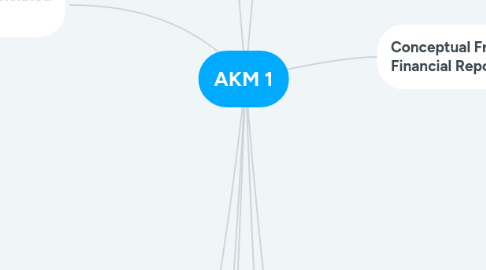
1. The Accounting Information System
1.1. Accounting Information System
1.1.1. Basic terminolgy
1.1.2. Debits and credits
1.1.3. The accounting equation
1.1.4. Financial statements and ownership structure
1.1.5. The accounting cycle
1.2. Record and Summarize Basic Transactions
1.2.1. Journalizing
1.2.2. Posting
1.2.3. Chart of accounts
1.2.4. The recording process illustrated
1.2.5. Trial balance
1.3. Identify and Prepare Adjusting Entries
1.3.1. Types of adjusting entries
1.3.2. Adjusting entries for deferrals
1.3.3. Adjusting entries for accruals
1.3.4. Adjusted trial balance
1.4. Preparing Financial Statements
1.4.1. Closing
1.4.2. Post closing trial balance
1.4.3. Reversing entries-an optional step
1.4.4. The accounting cycle summarized
1.5. Financial Statements for a Merchandising Company
1.5.1. Income Statement
1.5.2. Retained earnings statement
1.5.3. Statement of financial position
1.5.4. Closing entries
2. Income Statement and Related Information
2.1. Income Statement
2.1.1. Usefulness of the income statement
2.1.2. Limitations of the income statement
2.1.3. Quality of earnings
2.2. Content and Format of The Income Statement
2.2.1. Elements of the income statement
2.2.2. Intermediate components of the income statements
2.2.3. Condensed income statements
2.3. Reporting Various Income Statement
2.3.1. Gross profit
2.3.2. Income from operations
2.3.3. Income before income tax
2.3.4. Net income
2.3.5. Earning per share
2.3.6. Discontinued operations
2.3.7. Allocation to non controlling interest
2.3.8. Summary
2.4. Acconting Changes and Errors
2.4.1. Changes in accounting principle
2.4.2. Change in accounting estimates
2.4.3. Corrections of errors
2.4.4. Summary
2.5. Related Equity Statements
2.5.1. Retained Earnings Statement
2.5.2. Comprehensive income statement
2.5.3. Statement of changes in equity
3. Statement of Financial Position and Statement of Cash Flow
3.1. Statement of Financial Position
3.1.1. Usefulness of the statement of financial position
3.1.2. Limitations of the statement of financial position
3.1.3. Classification of the statement of financial position
3.2. Preparation of the Statement Financial Position
3.2.1. Account form
3.2.2. Report form
3.3. Statement of Cash Flows
3.3.1. Purpose of the statement of cash flows
3.3.2. Content of the statement of cash flows
3.3.3. Preparation of the statement of cash flows
3.3.4. Usefulness of the statement of cash flows
3.4. Additional Information
3.4.1. Notes to the financial statements
3.4.2. Techniques of disclosure
3.4.3. Other guidelines
4. Cash and Receivables
4.1. Cash
4.1.1. Reporting Cash
4.1.2. Summary of cash related items
4.2. Receivables
4.2.1. Recognition of accounts receivable
4.2.2. Measurement
4.2.3. Variable consideration
4.3. Valuation of Accounts Receivable
4.3.1. Direct write off method
4.3.2. Allowance method
4.4. Notes Receivable
4.4.1. Recognition of notes receivable
4.4.2. Valuation of notes receivable
4.5. Other Issues
4.5.1. Derecognition of receivables
4.5.2. Presentation and analysis
5. Inventories: Additional Valuation Issues
5.1. Lower of Cost or Net Realizable Value (LCNRV)
5.1.1. Net Realizable Value
5.1.2. Illustration of LCNRV
5.1.3. Application of LCNRV
5.1.4. Recording net realizable value
5.1.5. Use of an allowance
5.1.6. Recovery of inventory loss
5.1.7. Evaluation of rule
5.2. Valuation Bases
5.2.1. Net Realizable Value
5.2.2. Relative standalone sales value
5.2.3. Purchase commitments
5.3. Gross Profit Method
5.3.1. Gross profit percentage
5.3.2. Evaluation of method
5.4. Retail Inventory Method
5.4.1. Concepts
5.4.2. Conventional method
5.4.3. Special items
5.4.4. Evaluation of method
5.5. Presentation and Analysis
5.5.1. Presentation of inventories
5.5.2. Analysis of inventories
6. Financial Reporting and Accounting Standards
6.1. Global Market
6.1.1. Financial Statements and financial reporting
6.1.2. Accounting and capital allocation
6.1.3. High quality standards
6.2. Objective of Financial Reporting
6.2.1. General purpose financial statements
6.2.2. Equity investors and creditors
6.2.3. Entity perspective
6.2.4. Decision usefulness
6.3. Standard Setting Organizations
6.3.1. International Organization of Securities Comissions (IOSCO)
6.3.2. International Accounting Standars Board (IASB)
6.3.3. Hierarchy of IFRS
6.4. Financial Reporting Challenges
6.4.1. IFRS in political environment
6.4.2. The expectations gap
6.4.3. Significant financial reporting issues
6.4.4. Ethics in the environment of financial accounting
6.4.5. International convergence
6.4.6. Conclusion
7. Conceptual Framework for Financial Reporting
7.1. Conceptual Framework
7.1.1. Need for a conceptual framework
7.1.2. Development of a conceptual framework
7.1.3. Overview of the conceptual framework
7.1.4. Basic objective
7.2. Fundamental Concepts
7.2.1. Qualitative characteristics of accounting information
7.2.2. Basic elements
7.3. Assumptions
7.3.1. Economic entity
7.3.2. Going concern
7.3.3. Monetary unit
7.3.4. Periodicity
7.3.5. Accrual basis
7.4. Measurement, Recognition, and Disclosure Concepts
7.4.1. Basic principles of accounting
7.4.2. Cost constraint
7.4.3. Summary of the structure
8. Accounting and the Time Value of Money
8.1. Basic Time Value Concepts
8.1.1. Applications of time value concepts
8.1.2. The nature of interest
8.1.3. Simple interest
8.1.4. Compound interest
8.1.5. Fundamental variables
8.2. Single Sum Problems
8.2.1. Future value of a single sum
8.2.2. Present value of a single sum
8.2.3. Solving for other unknowns in single sum problems
8.3. Annuities (Future Value)
8.3.1. Future value of an ordinary annuity
8.3.2. Future value of an annuity due
8.3.3. Examples of future value problems of annuity
8.4. Annuities (Present Value)
8.4.1. Present value of an ordinary annuity
8.4.2. Present value of an annuity due
8.4.3. Examples of present value of annuity problems
8.5. Other Time Value of Money Issues
8.5.1. Deferred annuities
8.5.2. Valuation of long term bonds
8.5.3. Effective interest method of amortization of bond discount or premium amortization
8.5.4. Present value measurement
9. Valuation of Inventories: A Cost Basis Approach
9.1. Inventory Issues
9.1.1. Classification
9.1.2. Inventory cost flow
9.1.3. Inventory control
9.1.4. Determining cost of goods sold
9.2. Goods and Costs Included in Inventory
9.2.1. Goods included in inventory
9.2.2. Cost included in inventory
9.3. Which Cost Flow Assumption to Adopt
9.3.1. Specific identification
9.3.2. Average cost
9.3.3. First In First Out (FIFO)
9.3.4. Inventory valuation methods-summary analysis
9.4. Effect of Inventory Errors
9.4.1. Ending inventory misstated
9.4.2. Purchases and inventory

